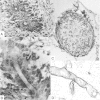Taxonomy of fungi causing mucormycosis and entomophthoramycosis (zygomycosis) and nomenclature of the disease: molecular mycologic perspectives
- PMID: 22247451
- PMCID: PMC3276235
- DOI: 10.1093/cid/cir864
Taxonomy of fungi causing mucormycosis and entomophthoramycosis (zygomycosis) and nomenclature of the disease: molecular mycologic perspectives
Abstract
Molecular phylogenetic analysis confirmed the phylum Zygomycota to be polyphyletic, and the taxa conventionally classified in Zygomycota are now distributed among the new phylum Glomeromycota and 4 subphyla incertae sedis (uncertain placement). Because the nomenclature of the disease zygomycosis was based on the phylum Zygomycota (Zygomycetes) in which the etiologic agents had been classified, the new classification profoundly affects the name of the disease. Zygomycosis was originally described as a convenient and inclusive name for 2 clinicopathologically different diseases, mucormycosis caused by members of Mucorales and entomophthoramycosis caused by species in the order Entomophthorales of Zygomycota. Without revision of original definition, the name "zygomycosis," however, has more often been used as a synonym only for mucormycosis. This article reviews the progress and changes in taxonomy and nomenclature of Zygomycota and the disease zygomycosis. The article also reiterates the reasons why the classic names "mucormycosis" and "entomophthoramycosis" are more appropriate than "zygomycosis."
Figures





References
-
- Whittaker RH. New concepts of kingdoms of organisms. Evolutionary relations are better represented by new classifications than by the traditional two kingdoms. Science. 1969;163:150–60. - PubMed
-
- Emmons CW, Binford CH, Utz JP, Kwon-Chung KJ. Medical mycology. 3rd ed. Philadelphia: Lea & Febiger; 1977. pp. 254–84.
-
- Ainsworth GC. Introduction and keys to higher taxa. In: Ainsworth GC, Sparrow FK, Sussman AS, editors. The fungi. IVA. A taxonomic review with keys. New York: Academic Press; 1973. pp. 1–7.
-
- Kirk PM, Cannon PF, David JC, Stalpers JA. Dictionary of the fungi. 9th ed. Wallingford, United Kingdom: CAB International; 2001.
-
- James TY, Kauff F, Schoch CL, et al. Reconstructing the early evolution of fungi using a six-gene phylogeny. Nature. 2006;443:818–22. - PubMed

